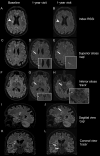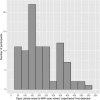Clinical Relevance of 'Cap' and 'Track' Development after Recent Small Subcortical Infarct
- PMID: 39821913
- PMCID: PMC12010063
- DOI: 10.1002/ana.27182
Clinical Relevance of 'Cap' and 'Track' Development after Recent Small Subcortical Infarct
Abstract
Objective: After a recent small subcortical infarct (RSSI), some patients develop perilesional or remote hyperintensities ('caps/tracks') to the index infarct on T2/FLAIR MRI. However, their clinical relevance remains unclear. We investigated the clinicoradiological correlates of 'caps/tracks', and their impact on long-term outcomes following RSSI.
Methods: We identified participants with lacunar stroke and MRI-confirmed RSSI from 3 prospective studies. At baseline, we collected risk factors, RSSI characteristics, small vessel disease (SVD) features, and microstructural integrity on diffusion imaging. Over 1-year, we repeated MRI and recorded 'caps/tracks' blinded to other data. We evaluated predictors of 'caps/tracks', and their association with 1-year functional (modified Rankin Scale score ≥2), mobility (Timed Up-and-Go), cognitive outcomes (Montreal Cognitive Assessment [MoCA] score <26), and recurrent cerebrovascular events (stroke/transient ischemic attack/incident infarct) using multivariable regression.
Results: Among 185 participants, 93 (50.3%) developed 'caps/tracks' first detected at median 198 days after stroke. 'Caps/tracks' were independently predicted by baseline factors: larger RSSI, RSSI located in white matter, higher SVD score, and higher mean diffusivity in normal-appearing white matter (odds ratio [OR] [95% confidence interval {CI}], 1.15 [1.07-1.25], 6.01 [2.80-13.57], 1.77 [1.31-2.44], 1.42 [1.01-2.03]). At 1 year, 'cap/track' formation was associated with worse functional outcome (OR: 3.17, 95% CI: 1.28-8.22), slower gait speed (β: 0.13, 95% CI: 0.01-0.25), and recurrent cerebrovascular events (hazard ratio [HR]: 2.05, 95% CI: 1.05-4.02), but not with cognitive impairment.
Interpretation: 'Caps/tracks' after RSSI are associated with worse clinical outcomes, and may reflect vulnerability to progressive SVD-related injury. Reducing 'caps/tracks' may offer early efficacy markers in trials aiming to improve outcome after lacunar stroke. ANN NEUROL 2025;97:942-955.
© 2025 The Author(s). Annals of Neurology published by Wiley Periodicals LLC on behalf of American Neurological Association.
Conflict of interest statement
Nothing to report.
Figures





References
-
- Wardlaw JM, Doubal F, Armitage P, et al. Lacunar stroke is associated with diffuse blood‐brain barrier dysfunction. Ann Neurol 2009;65:194–202. - PubMed
-
- Duering M, Biessels GJ, Brodtmann A, et al. Neuroimaging standards for research into small vessel disease—advances since 2013. Lancet Neurol 2023;22:602–618. - PubMed
-
- Norrving B. Long‐term prognosis after lacunar infarction. Lancet Neurol 2003;2:238–245. - PubMed
MeSH terms
Grants and funding
- 16 CVD 05/Fondation Leducq Network for the Study of Perivascular Spaces in Small Vessel Disease
- RE/18/5/34216/British Heart Foundation Edinburgh Centre for Research Excellence
- 2023YFC2506603/National Key Research and Development Program of China
- SAPG 19n100068/Stroke Association 'Small Vessel Disease-Spotlight on Symptoms (SVD-SOS)'
- SA PDF 23\100007/Stroke Association Postdoctoral Fellowship
- Anne Rowling Regenerative Neurology Clinic
- CAF/18/08/CSO_/Chief Scientist Office/United Kingdom
- Muir Maxwell Research Fund
- WT_/Wellcome Trust/United Kingdom
- 2012/17/Edinburgh and Lothians Health Foundation
- 2021-00000701EXTF-00234/Mexican Council of Humanities Science and Technology
- (SA PDF 18\100026) TSA Str/TSA Wiseman Stroke Association Postdoctoral Fellowship
- AD.ROW4.35/The Row Fogo Charitable Trust Centre for Research into Aging and the Brain
- TSALECT2015/04/Stroke Association Garfield Weston Foundation
- UKDRI-4002/MRC_/Medical Research Council/United Kingdom
- CSC202006240281/Chinese Government Scholarship
- BB/W008793/1/Biotechnology and Biological Sciences Research Council, and the Economic and Social Research Council
- BRO-D.FID3668413/The Row Fogo Charitable Trust Centre for Research into Aging and the Brain
- NHS Research Scotland
- R380R/1114/Dunhill Trust
- University of Edinburgh College of Medicine and Veterinary Medicine
- 666881/European Union Horizon 2020
- 2024HXBH041/Postdoctor Research Fund of West China Hospital, Sichuan University
- NHS Lothian Research and Development Office
LinkOut - more resources
Full Text Sources
Miscellaneous

